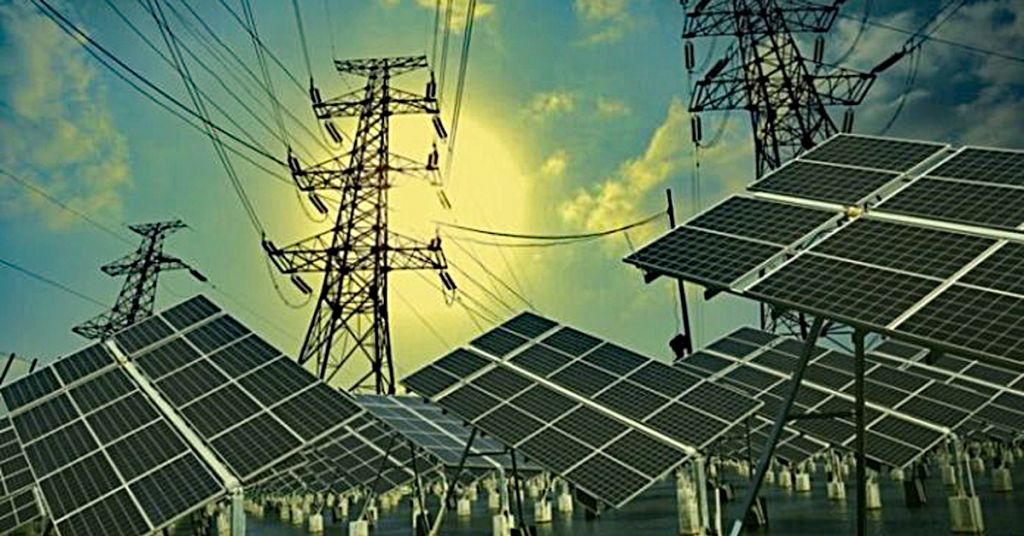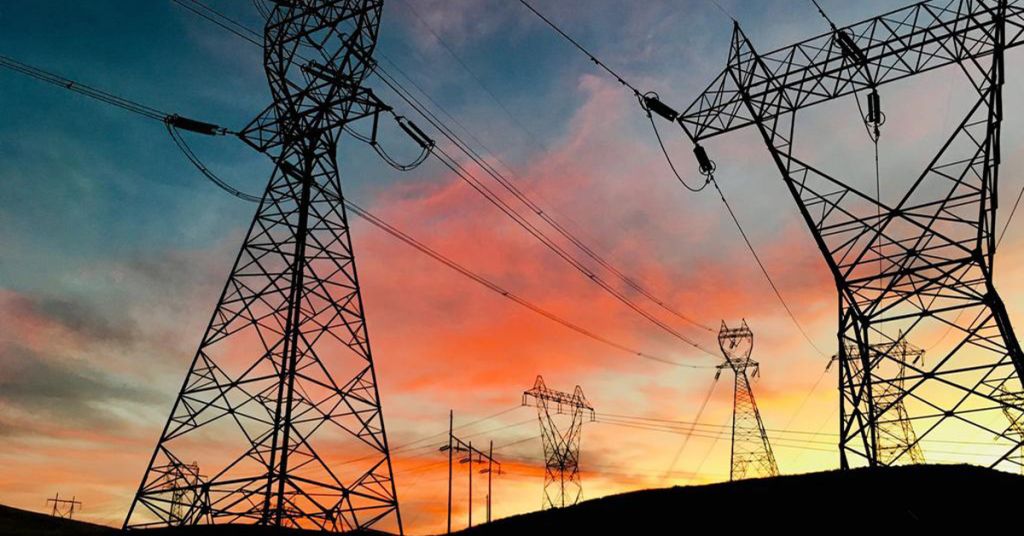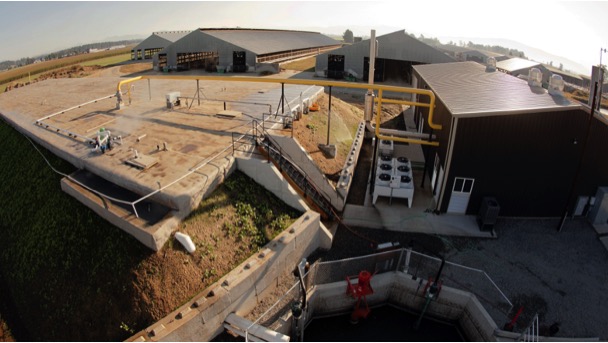
[/media-credit] Werkhoven Dairy Biodigester
By Nancy Webb, Jan. 11, 2016
What is a digester?
For anyone interested in recycling of resources, this article shows one way to repurpose a natural element for mutual benefit.
At the basic level, a digester turns cow manure into electricity. While the entire setup is called the digester, it is actually one piece of the system. They can repurpose every component in the waste stream to use for electricity, compost, and additional energy from the methane burn off. To explain how dairy digesters work we’re using one as an example.
The Flow
 [/media-credit]
[/media-credit]
Cows manure goes to…
Vat with other solids which flows to…
Digester which creates biogas that flows to…
Generator which creates electricity which goes to…
Transformer that sends the electricity to…
Power utility (like: Snohomish County PUD, Klickitat County PUD, Pacific Power).
The digester for this article is located on the Werkhoven Farm in Monroe, Washington. It’s a partnership between Qualco Energy, the Werkhoven family, the Tulalip tribes and PUD of Snohomish County. Before the dairy took them, the leftovers from restaurants, food processing plants went down the sewer or into a landfill. The leftover solids are nearly 100 percent pathogen-free compost for gardens and liquids for spraying onto the fields. The separated waste is given away for compost.
“Since we turned on the switch, it’s been operating everyday and generates $25,000 per month just from the clean electricity we sell back to our local utility.” -Jon Van Nieuwenhuyzen, Werkhoven Dairy/Qualco Energy
Why build a digester?
- Energy is used to power the digester itself so self-sufficient.
- Provide energy for entire farm and/or industrial plant.
- Excess clean energy can be sold to a utility at a profit.
- Money from sold energy is used to protect salmon habitats.
- Food wastes recycled instead of going down the drain.
What makes up a digester?
- Cows provide the initial ingredient – manure
- Vat or pit – where the ingredients are mixed
- Digester – breaks down the solids
- Generator – power created
- Transformer – sends converted power from generator to energy utility
IT STARTS WITH THE COWS
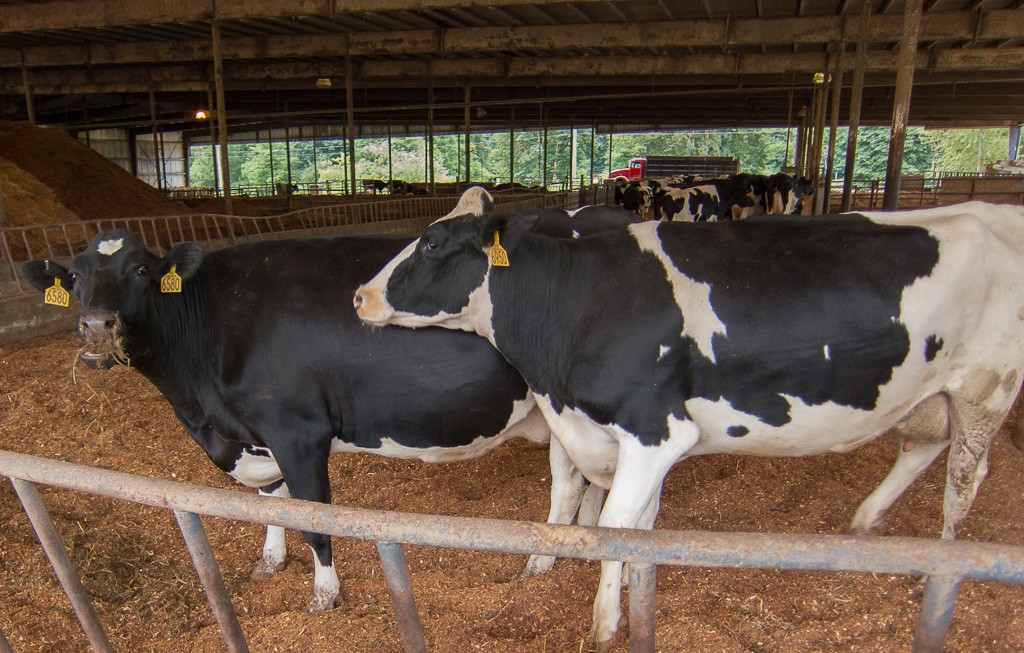 Jurgen Hess
Jurgen HessWhat makes this manure special?
From a 5,000-gallon black tank containing beer and wine, Andy Werkhoven adds two pounds of alcohol to the feed of each of the 1,000 milking cows. “Cow-bernet,” he jokes. Also a little Bud Light, Coors and any other out-of-date alcohol stores can’t sell because of expiration dates that have passed. The sugar gives the animals extra energy but the alcohol does not affect the milk. The dairy diet is designed by a nutritionist who visits weekly that includes:
- Whey left over from the production of cottage cheese at the Issaquah Darigold plant
- Flour rejected for human use
- Eggs past their expiration date
- Leftover brewers’ grain
- Mix of corn silage, alfalfa and molasses
What happens to all the manure?
In the cow barn are slotted alleyways. The manure is washed down the alley then into an underground pipe that empties out into a pit also known as ‘the lagoon’ where the mixing starts. What the cows don’t eat goes into the digester via underground pipes that carry the separated waste products from the dairy to the plant. The leftover solids are nearly 100 percent pathogen-free compost for gardens and liquids for spraying onto the fields.
THE LAGOON
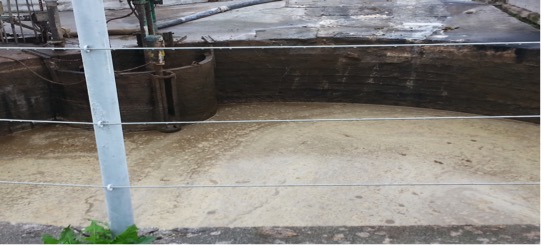 [/media-credit]
[/media-credit]
What goes into the lagoon?
Every 20 minutes, waste from the underground pipe coming from the cow barn is dumped into a large vat also known as “The Lagoon.” The ingredients are mixed together to combine before moving to the digester. Combined with the manure, these yummy items are also thrown in.
- Expired soda and alcohol including leftover beer and wine
- ‘Sloppy stuff’ from food wastes that has fat and protein
- Bad batches of soup from Stockpot Soups in Everett
- Recycled cooking oil from restaurants
- Animal blood
- Fish waste from Trident Foods
Andy Werkhoven adds two pounds of alcohol to the feed of each of the 1,000 milking cows. ‘Cow-bernet,’ he jokes.
THE DIGESTER

[/media-credit] The digester.
Biogas production
From The Lagoon, the mixture moves via underground pipes to the actual digester which can be up to a football field long. The Werkhoven digester is made up of five underground chambers and is always about – full to provide biogas production.
The depth of the digester at the Monroe facility is 20 feet and maintains a temperature of around 100 degrees. The whole process takes place underground so there is virtually no odor.
The nutrients that are in the manure are broken down and float to the bottom of the tank. The biogas created flows to the generator which is in a building next to the digester.
As a side note, the separated solids are bagged for compost and currently given away to local farmers.
What’s in that flame?
Methane, a potent greenhouse gas, is captured and converted into clean electricity called biogas from the decaying organic material in the digester. The methane flame burns off any extra gas not forced down into the mix to heat it. There is about 55 to 65 % methane gas.
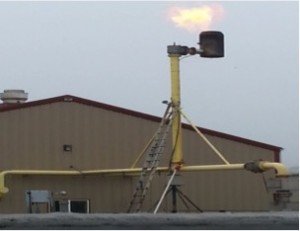 [/media-credit]
[/media-credit]
As the manure continuously breaks down, the resulting biogas is sent through pipes from the digester to the generator located on the property. The flare off is looked at as being used to heat other facilities such as greenhouses which can provide product for year round availability.
ELECTRICITY IS CREATED
The biogas created by the digester flows to the generator. The generator then powers the 450-kilowatt generator. It currently produces two times as much gas as the single 450-kilowatt generator can use. Qualco Energy’s digester runs on a variety of substrates and is rebuilt every 4 years. Their generator powers 300 homes. As active community members, the Werkhovens are planning with local government officials to ensure a second generator can deliver maximum benefit to all involved.
They also allow access to Washington State University researchers, who study manure management and nutrient management. Qualco Energy enables the researchers to work on what otherwise be off-limits tribal ground, changing perspectives about the land’s utility. “It’s not about us,” Andy repeats. “This is a partnership that will change the game.” A software programs shows the amount of electricity and how much flare off occurs. There are 24-hour alerts if anything breaks down on the equipment.
The transformer located on the same property sends electricity from the generator directly to Snohomish County PUD. The process currently generates enough electricity to power over 300 homes.
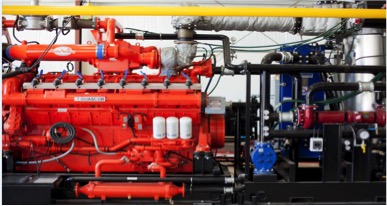
[/media-credit] The generator.
As dairy farmers everywhere seek to stay in business and meet tougher-than-ever environmental standards, they are finding new ways not only to feed cows, as Andy and his brother Jim Werkhoven have discovered, but to deal with the waste as well – turning manure into money by letting it generate electricity.
Areas of concern
- Gas releases that are flammable, explosive or immediately toxic.
- Hydrogen Sulfide gas, which can accumulate in the bottom of tanks and pump sumps, can kill almost instantaneously.
- Carbon Monoxide gas can accumulate in engine and machine rooms from engine exhaust and poorly operating boilers.
- Biogas can accumulate under roofs and ceilings in explosive mixtures
- Confined spaces that may be immediately hazardous to life and should only be entered using appropriate procedures and equipment.
- Noise levels that require workers to wear hearing protection.
- Liquid tanks and ponds that may result in drowning.
- Pumps and other machinery that are entanglement hazards due to rotating shafts, pinch points and other moving parts.
- Biogas and manure liquids that cause rapid corrosion or failure of electrical equipment, gas handling piping and building components.
- Small children and unaware visitors who can wonder into areas of danger and become serious injured or drown.
- Ladders, platforms and roofs without guards, cages or other fall prevention measures.
- Dirty liquids and gases escaping under high pressure.
*A special thank you to Daryl Williams, the Environmental Liaison with Tulalip Tribes for an excellent tour of the digester in Monroe.
*Also, thank you Regenis for providing photographs for this arcticle.





